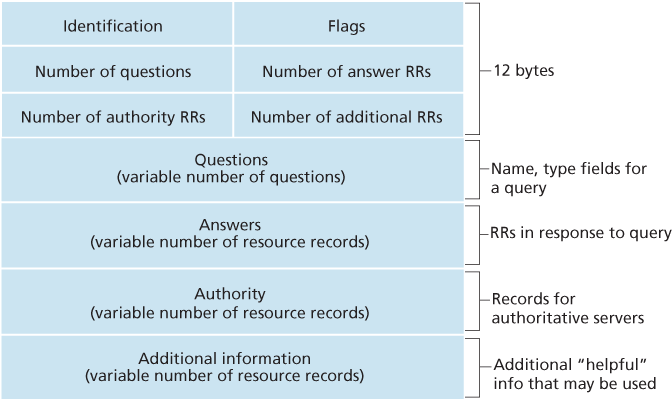Chapter 2 Application Layer
2.1 Principles of Network Applications
2.1.1 Network Application Architectures
In choosing the application architecture, an application developer will likely draw on one of the two predominant architectural paradigms used in modern network applications: the client-server architecture or the peer-to-peer (P2P) architecture.
2.1.2 Processes Communicating
Client and Server Processes
A network application consists of pairs of processes that send messages to each other over a network.
In the context of a communication session between a pair of processes, the process that initiates the communication (that is, initially contacts the other process at the beginning of the session) is labeled as the client. The process that waits to be contacted to begin the session is the server.
The Interface Between the Process and the Computer Network
The network through a software interface called a socket.
A socket is the interface between the application layer and the transport layer within a host. It is also referred to as the Application Programming Interface (API) between the application and the network, since the socket is the programming interface with which network applications are built. The application developer has control of everything on the application-layer side of the socket but has little control of the transport-layer side of the socket. The only control that the application developer has on the transport-layer side is (1) the choice of transport protocol and (2) perhaps the ability to fix a few transport-layer parameters such as maximum buffer and maximum segment sizes.
Addressing Processes

To identify the receiving process, two pieces of information need to be specified: (1) the address of the host and (2) an identifier that specifies the receiving process in the destination host.
In the Internet, the host is identified by its IP address. IP address is a 32-bit quantity that we can think of as uniquely identifying the host. In addition to knowing the address of the host to which a message is destined, the sending process must also identify the receiving process (more specifically, the receiving socket) running in the host. This information is needed because in general a host could be running many network applications. A destination port number serves this purpose.
2.1.3 Transport Services Available to Applications
The application at the sending side pushes messages through the socket. At the other side of the socket, the transport-layer protocol has the responsibility of getting the messages to the socket of the receiving process.
Reliable Data Transfer
If a protocol provides such a guaranteed data delivery service, it is said to provide reliable data transfer. One important service that a transport-layer protocol can potentially provide to an application is process-to-process reliable data transfer. When a transport protocol provides this service, the sending process can just pass its data into the socket and know with complete confidence that the data will arrive without errors at the receiving process.
When a transport-layer protocol doesn’t provide reliable data transfer, some of the data sent by the sending process may never arrive at the receiving process. This may be acceptable for loss-tolerant applications, most notably multimedia applications such as conversational audio/video that can tolerate some amount of data loss. In these multimedia applications, lost data might result in a small glitch in the audio/video—not a crucial impairment.
Throughput
A transport-layer protocol could provide, namely, guaranteed available throughput at some specified rate. Applications that have throughput requirements are said to be bandwidth-sensitive applications.
Timing
A transport-layer protocol can also provide timing guarantees. An example guarantee might be that every bit that the sender pumps into the socket arrives at the receiver’s socket no more than 100 msec later.
Security
A transport protocol can provide an application with one or more security services. For example, in the sending host, a transport protocol can encrypt all data transmitted by the sending process, and in the receiving host, the transport-layer protocol can decrypt the data before delivering the data to the receiving process. Such a service would provide confidentiality between the two processes, even if the data is somehow observed between sending and receiving processes.
2.1.4 Transport Services Provided by the Internet
TCP Services
The TCP service model includes a connection-oriented service and a reliable data transfer service. When an application invokes TCP as its transport protocol, the application receives both of these services from TCP.
- Connection-oriented service. TCP has the client and server exchange transport-layer control information with each other before the application-level messages begin to flow. This so-called handshaking procedure alerts the client and server, allowing them to prepare for an onslaught of packets. After the handshaking phase, a TCP connection is said to exist between the sockets of the two processes. The connection is a full-duplex connection in that the two processes can send messages to each other over the connection at the same time. When the application finishes sending messages, it must tear down the connection.
- Reliable data transfer service. The communicating processes can rely on TCP to deliver all data sent without error and in the proper order. When one side of the application passes a stream of bytes into a socket, it can count on TCP to deliver the same stream of bytes to the receiving socket, with no missing or duplicate bytes.
TCP also includes a congestion-control mechanism, a service for the general welfare of the Internet rather than for the direct benefit of the communicating processes. The TCP congestion-control mechanism throttles a sending process (client or server) when the network is congested between sender and receiver.
FOCUS ON SECURITY
Neither TCP nor UDP provides any encryption—the data that the sending process passes into its socket is the same data that travels over the network to the destination process.
Because privacy and other security issues have become critical for many applications, the Internet community has developed an enhancement for TCP, called Secure Sockets Layer (SSL). TCP-enhanced-with-SSL not only does everything that traditional TCP does but also provides critical process-to-process security services, including encryption, data integrity, and end-point authentication. We emphasize that SSL is not a third Internet transport protocol, on the same level as TCP and UDP, but instead is an enhancement of TCP, with the enhancements being implemented in the application layer. In particular, if an application wants to use the services of SSL, it needs to include SSL code (existing, highly optimized libraries and classes) in both the client and server sides of the application. SSL has its own socket API that is similar to the traditional TCP socket API.
UDP Services
UDP is a no-frills, lightweight transport protocol, providing minimal services. UDP is connectionless, so there is no handshaking before the two processes start to communicate. UDP provides an unreliable data transfer service.
UDP does not include a congestion-control mechanism.
2.1.5 Application-Layer Protocols
An application-layer protocol defines how an application’s processes, running on different end systems, pass messages to each other. In particular, an application-layer protocol defines:
- The types of messages exchanged, for example, request messages and response messages
- The syntax of the various message types, such as the fields in the message and how the fields are delineated
- The semantics of the fields, that is, the meaning of the information in the fields
- Rules for determining when and how a process sends messages and responds to messages
Some application-layer protocols are specified in RFCs and are therefore in the public domain. For example, the Web’s application-layer protocol, HTTP (the HyperText Transfer Protocol [RFC 2616]), is available as an RFC. Many other application-layer protocols are proprietary and intentionally not available in the public domain. For example, Skype uses proprietary application-layer protocols.
2.2 The Web and HTTP
2.2.1 Overview of HTTP
The HyperText Transfer Protocol (HTTP), the Web’s application-layer protocol, is at the heart of the Web. It is defined in [RFC 1945] and [RFC 2616]. HTTP defines the structure of these messages and how the client and server exchange the messages.
HTTP uses TCP as its underlying transport protocol (rather than running on top of UDP). The HTTP client first initiates a TCP connection with the server.
It is important to note that the server sends requested files to clients without storing any state information about the client. If a particular client asks for the same object twice in a period of a few seconds, the server does not respond by saying that it just served the object to the client; instead, the server resends the object, as it has completely forgotten what it did earlier. Because an HTTP server maintains no information about the clients, HTTP is said to be a stateless protocol.
2.2.2 Non-Persistent and Persistent Connections
When this client-server interaction is taking place over TCP, the application developer needs to make an important decision—should each request/response pair be sent over a separate TCP connection, or should all of the requests and their corresponding responses be sent over the same TCP connection? In the former approach, the application is said to use non-persistent connections; and in the latter approach, persistent connections. Although HTTP uses persistent connections in its default mode, HTTP clients and servers can be configured to use non-persistent connections instead.
2.2.3 HTTP Message Format
HTTP Request Message
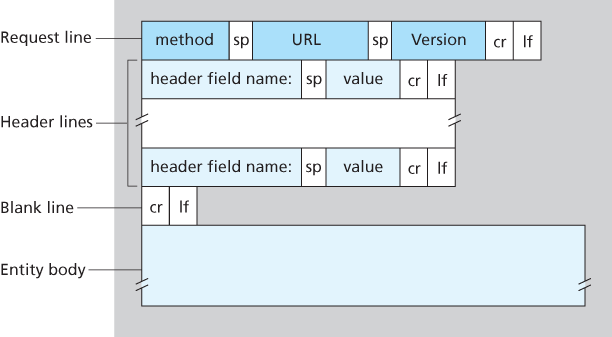
HTTP Response Message
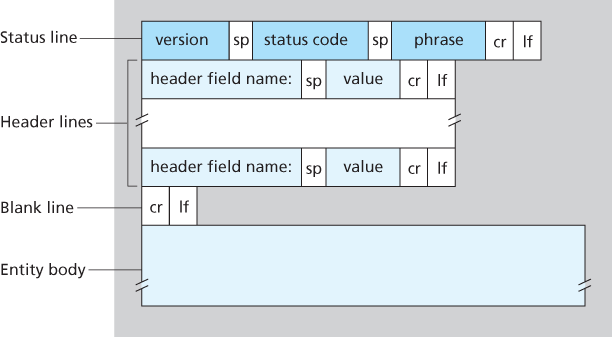
2.2.4 User-Server Interaction: Cookies
HTTP uses cookies. Cookies, defined in [RFC 6265], allow sites to keep track of users.
2.4 DNS—The Internet’s Directory Service
2.4.1 Services Provided by DNS
We need a directory service that translates hostnames to IP addresses. This is the main task of the Internet’s domain name system (DNS). The DNS is (1) a distributed database implemented in a hierarchy of DNS servers, and (2) an application-layer protocol that allows hosts to query the distributed database.
DNS adds an additional delay—sometimes substantial—to the Internet applications that use it.
DNS provides a few other important services in addition to translating hostnames to IP addresses:
- Host aliasing. A host with a complicated hostname can have one or more alias names. For example, a hostname such as
relay1.west-coast.enterprise.comcould have, say, two aliases such asenterprise.comandwww.enterprise.com. In this case, the hostnamerelay1.west-coast.enterprise.comis said to be a canonical hostname. Alias hostnames, when present, are typically more mnemonic than canonical hostnames. DNS can be invoked by an application to obtain the canonical hostname for a supplied alias hostname as well as the IP address of the host. - Mail server aliasing.
- Load distribution. DNS is also used to perform load distribution among replicated servers, such as replicated Web servers. Busy sites, such as
cnn.com, are replicated over multiple servers, with each server running on a different end system and each having a different IP address. For replicated Web servers, a set of IP addresses is thus associated with one canonical hostname. The DNS database contains this set of IP addresses. When clients make a DNS query for a name mapped to a set of addresses, the server responds with the entire set of IP addresses, but rotates the ordering of the addresses within each reply. Because a client typically sends its HTTP request message to the IP address that is listed first in the set, DNS rotation distributes the traffic among the replicated servers. DNS rotation is also used for e-mail so that multiple mail servers can have the same alias name. Also, content distribution companies such as Akamai have used DNS in more sophisticated ways [Dilley 2002] to provide Web content distribution.
2.4.2 Overview of How DNS Works
A Distributed, Hierarchical Database
In order to deal with the issue of scale, the DNS uses a large number of servers, organized in a hierarchical fashion and distributed around the world. No single DNS server has all of the mappings for all of the hosts in the Internet. Instead, the mappings are distributed across the DNS servers. To a first approximation, there are three classes of DNS servers—root DNS servers, top-level domain (TLD) DNS servers, and authoritative DNS servers.
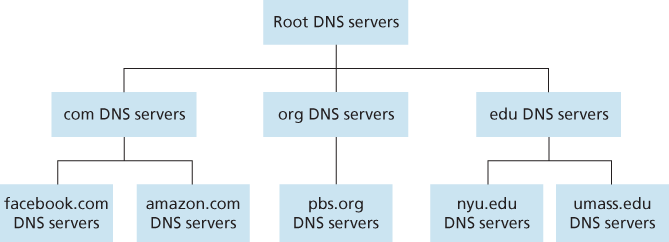
There is another important type of DNS server called the local DNS server. A local DNS server does not strictly belong to the hierarchy of servers but is nevertheless central to the DNS architecture. Each ISP—such as a residential ISP or an institutional ISP—has a local DNS server (also called a default name server).
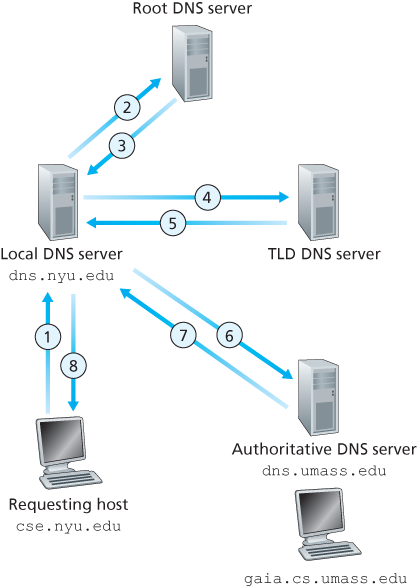
DNS Caching
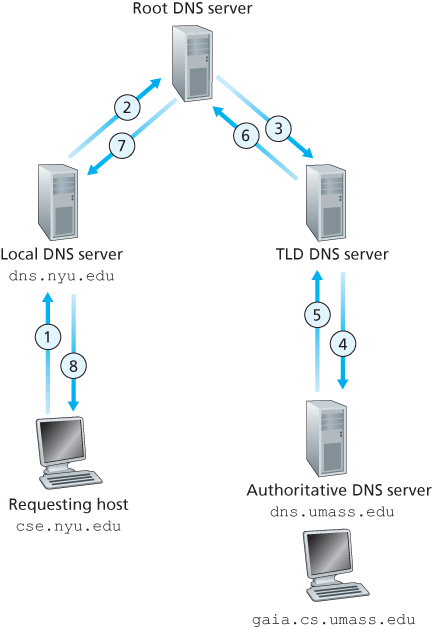
2.4.3 DNS Records and Messages
The DNS servers that together implement the DNS distributed database store resource records (RRs), including RRs that provide hostname-to-IP address mappings.
A resource record is a four-tuple that contains the following fields:
(Name, Value, Type, TTL)language-none
TTL is the time to live of the resource record; it determines when a resource should be removed from a cache. The meaning of Name and Value depend on Type:
- If
Type=A, thenNameis a hostname andValueis the IP address for the hostname. Thus, a Type A record provides the standard hostname-to-IP address mapping. As an example,(relay1.bar.foo.com, 145.37.93.126, A)is a Type A record. - If
Type=NS, thenNameis a domain (such asfoo.com) andValueis the hostname of an authoritative DNS server that knows how to obtain the IP addresses for hosts in the domain. This record is used to route DNS queries further along in the query chain. As an example,(foo.com, dns.foo.com, NS)is a Type NS record. - If
Type=CNAME, thenValueis a canonical hostname for the alias hostnameName. This record can provide querying hosts the canonical name for a hostname. As an example,(foo.com, relay1.bar.foo.com, CNAME)is a CNAME record. - If
Type=MX, thenValueis the canonical name of a mail server that has an alias hostnameName. As an example,(foo.com, mail.bar.foo.com, MX)is an MX record. MX records allow the hostnames of mail servers to have simple aliases. Note that by using the MX record, a company can have the same aliased name for its mail server and for one of its other servers (such as its Web server). To obtain the canonical name for the mail server, a DNS client would query for an MX record; to obtain the canonical name for the other server, the DNS client would query for the CNAME record.
DNS Messages
These are the only two kinds of DNS messages. Furthermore, both query and reply messages have the same format:
